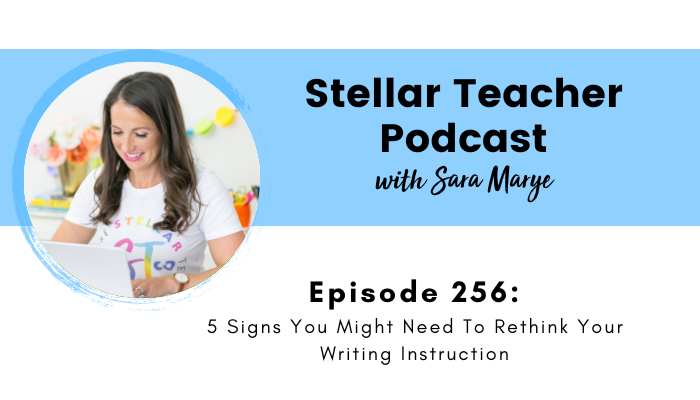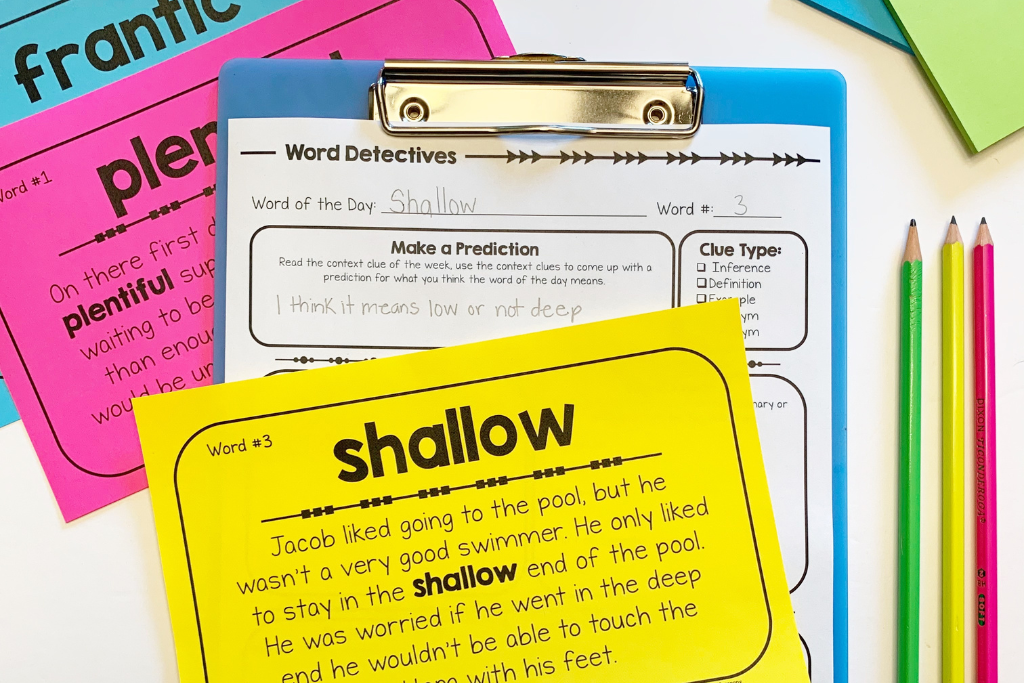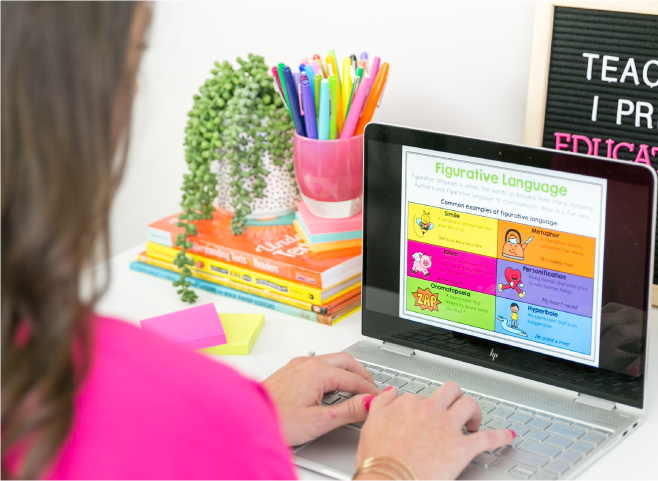
Click play below to listen to 5 signs that you may need to rethink your writing instruction.
Writing instruction in upper elementary can often feel overwhelming, especially when your students are expected to produce multi-paragraph essays—but struggle to write a clear sentence. In this episode, we’re taking a step back to reflect on what effective writing instruction really looks like. If you’ve ever felt unsure about your writing block or questioned whether your current approach is helping students grow, you’re not alone.
We’re breaking down five common signs that it might be time to rethink your writing instruction. From assigning writing instead of explicitly teaching it, to skipping sentence-level work and fast-forwarding to essays, we’ll unpack the most frequent challenges teachers face—and offer simple, actionable shifts you can make to see real progress in your classroom.
Whether you’re looking for new strategies, a mindset reset, or just a little encouragement, this episode will help you feel more confident and empowered as a writing teacher. It’s never too late to rethink your writing instruction and make changes that will transform your students’ writing outcomes all year long.
In this episode on why you may want to rethink your writing instruction, I share:
- What it really means to rethink your writing instruction—and why it matters for student growth
- The difference between assigning writing and explicitly teaching it
- Why jumping straight into essays can actually slow down student progress
- How sentence-level instruction lays the foundation for all other writing
- The hidden power of planning and revising in the writing process
- Why isolated grammar worksheets don’t lead to stronger writing
- Simple ways to embed grammar into meaningful writing practice
- Why now is the perfect time to pause, reflect, and rethink your writing instruction for next year
- Practical examples that show what it looks like to rethink your writing instruction in everyday lessons
Episode Resources:
Register for our Stellar Teacher Summer Book Study
More Resources:
- Join The Stellar Literacy Collective
- Sign up for my Private Podcast: Confident Writer Systems Series
- Sign up for my FREE Revision Made Easy email series
- If you’re enjoying this podcast, please leave a review on Apple Podcasts!
Related Episodes and Blog Posts:
- Episode 228, The Power of Outlining: 3 Strategies to Strengthen Student Writing
- Episode 217, How to Integrate Writing Instruction Across All Subjects
- Episode 186, Don’t Let Grammar Be the Star of Your Writing Block! Do This Instead
- From Ideas to Essays: The Power of Outlining in Upper Elementary Writing
- Transforming Grammar Instruction: Strategies for Effective Application in Writing
Connect with me:
- Join my newsletter
- Shop my TPT store here
- Subscribe to our YouTube channel
- Instagram: @thestellarteachercompany
- Facebook: The Stellar Teacher Company
More About Stellar Teacher Podcast:
Welcome to the Stellar Teacher Podcast! We believe teaching literacy is a skill. It takes a lot of time, practice, and effort to be good at it. This podcast will show you how to level up your literacy instruction and make a massive impact on your students, all while having a little fun!
Your host, Sara Marye, is a literacy specialist passionate about helping elementary teachers around the world pass on their love of reading to their students. She has over a decade of experience working as a classroom teacher and school administrator. Sara has made it her mission to create high-quality, no-fluff resources and lesson ideas that are both meaningful and engaging for young readers.
Each week, Sara and her guests will share their knowledge, tips, and tricks so that you can feel confident in your ability to transform your students into life-long readers.
Tune in on your favorite podcast platform: Apple, Google, Amazon, Spotify, Castbox, and more! If you’re loving this podcast, please rate, review, and follow!
Podcast (stellar-teacher-podcast): Play in new window | Download
Hey, friend, welcome back to the podcast. Today, we are kicking off a four-week special summer series that is all about writing instruction. This series is inspired by The Writing Revolution 2.0, which is the book we are diving into for our summer book study.
Now, if you are a part of our summer book study, we are so excited that we get to spend part of your summer with you. Be sure to tune in to our podcast each week for an extra dose of writing encouragement. And if you’re not part of the book study, you can definitely still benefit from these podcast episodes. Also, it’s not too late to join us — you can sign up at stellarteacher.com/bookstudy.
We are just kicking off Week Two of our book study this week, but the replay from our first call is still available inside our book study Facebook group, so you are definitely not too late to jump in and join us.
This week’s episode is all about taking a quick pulse check on your writing instruction and really considering if your approach to writing is working. If we’re honest with ourselves, I think we can all probably agree that writing is one of those subjects that can feel really overwhelming, and sometimes we’re unsure if the way we’re teaching writing is actually working—especially in upper elementary.
So today, I’m going to share five signs that might mean it’s time for you to rethink your writing instruction. Now, no judgment here. All of the things I share are things that I did myself when I was in the classroom. And of course, my goal with this episode is to help you see some easy shifts you can make, so that way you can start being more effective and feeling more confident as a writing teacher.
So let’s go ahead and jump right in.
Okay, let’s start with the first sign: you assign writing more than you explicitly teach it. And here’s what I mean. It’s really easy to hand your students a prompt like, “Write about your summer vacation,” and then hope that they figure it out on their own. But assigning writing and teaching writing are two completely different things.
When we assign writing, we’re basically saying, “Here’s what to write about. Now, go do it.” But explicit writing instruction means that we are really showing our students how to do it. We’re showing them how to write strong sentences. We’re showing them how to organize their ideas into paragraphs. We’re showing them how to revise and improve their word choice.
So if you’ve historically just been assigning prompts, but you’re not explicitly teaching writing skills—or you’re not really intentionally building a strong writing foundation—your students might be stuck or unsure what to do next. And you’re probably not seeing a lot of growth in their writing.
But here’s the good news: this is such an easy and fixable shift to make. And ultimately, it starts with you carving out time and committing to providing explicit writing instruction, even if that’s just ten minutes during your writing block. Or maybe you find ways to bring explicit writing instruction into other parts of your instructional day. You don’t even have to have a dedicated writing block to provide strong instruction.
And maybe you’re realizing, “Okay, as I think about this, I really only assign writing. I’ve never actually taught it. But I don’t even know how to explicitly teach writing.” I get it, because I’ve been there too. When I was in the classroom, I did a lot of assigning writing and not as much teaching writing.
But I think that’s one of the things I really love most about The Writing Revolution. I remember when I read through it the first time, I thought, “Oh my gosh, I needed this when I was in the classroom!” Because it’s full of specific strategies and activities that you can bring right into your writing block. It has real examples of explicit writing instruction that you can start using right away.
One of the things that really stood out to me in The Writing Revolution is how they explain that most students won’t just pick up writing skills by reading. Even students who are great readers often struggle with writing, and I definitely saw that in my classroom. I think sometimes we assume that if a student is a good reader, then they will automatically be a good writer. But the book explains that written language usually uses more complex sentences and more precise vocabulary than our spoken language.
When we talk, we don’t usually use words like despite or although, but these words can be really powerful in writing. And since it’s not necessarily natural for us to speak using the same structure that we use when we write, we really have to teach it directly to our students. Like I said, explicit writing instruction is definitely something we need to prioritize.
The good news is that it doesn’t have to take a ton of extra time. It can happen in short bursts, and you can weave it in throughout your day. So even if you feel like you don’t have one more thing to add to your plate, you don’t need to—because it’s not about trying to find more time for explicit writing instruction. It’s just about being a little more strategic with how we approach it.
The second sign is something I see and hear often: you’re jumping straight into essays and skipping sentence-level instruction. I think this is especially common if you’re an upper elementary teacher in a state that requires your students to write a multi-paragraph essay or a longer response on the end-of-year state test. That was my experience, and if that’s your reality, we can feel this pressure to get students ready for those big, scary essays. So our natural response is to just jump right in and start working on essays.
Like I said, that’s exactly what I did when I taught fourth grade. I always remember that during the very first week of school, we were already working on our first personal narrative essay. But here’s the deal: if students can’t write a clear, interesting, detailed sentence, they’re really going to struggle to write a clear, interesting, detailed essay.
In The Writing Revolution, one thing they say is that the importance of spending plenty of instructional time working with sentences can’t be stressed enough. That was definitely an “aha” moment I had when reading the book, because I never spent any time focusing on sentences as a fourth grade teacher. But really, sentence-level instruction is the engine that drives everything else we do in writing.
I want you to think of writing like building a house. You would never start working on the roof if you hadn’t laid a solid foundation and built up the framing first. Ultimately, in writing, sentences are that foundation. We can’t skip ahead to the roof if we don’t have a foundation to build on.
So if sentence-level instruction is something you’ve skipped in the past, don’t worry. Like I said, I did too when I was in the classroom. And ultimately, I think I didn’t realize that as an upper elementary teacher, I needed to be spending time on sentence-level practice. I actually think that’s a pretty common misconception among upper elementary teachers.
We feel pressure from state testing, and we’re often handed really poor-quality writing materials. The materials we’re given don’t even prioritize sentence-level writing the way they should. I also think sometimes we just don’t know how to help our students build strong sentence writing skills.
In my head, I always thought, “My students have to write an essay by the end of the year, so let’s just jump in and start working on essays now, so we have the whole year to improve.” But that’s not how writing instruction works—and honestly, that’s not even how teaching necessarily works.
I know I’ve said this before in a different workshop, but it’s worth repeating: your standards and end-of-year expectations tell you what your students need to do, but they don’t tell you how to get there. And even if it sounds a little bit backwards, if essays are your end-of-year goal, the fastest way to get your students there is to make sure they can write really strong sentences. If sentence writing feels like it’s slowing you down, that’s where we need a mindset shift. We need to remind ourselves that we sometimes have to slow down so we can speed up later.
Because here’s the real truth: if your students don’t have a solid foundation with sentences, all that time you’re spending on essays at the start of the year is going to be wasted time and wasted effort. Your students have to have strong sentence writing skills in order to write anything else well.
Again, this is one of my favorite parts of The Writing Revolution—their entire section on sentence writing. Once teachers realize how crucial sentence-level writing is, they then have the knowledge, strategies, and very practical things they can do in their classroom to help students make real, meaningful progress in their writing.
We’ve taken a lot of the strategies we’ve learned from The Writing Revolution and embedded them into our sentence writing routine and our reading resources. Time and time again, we hear from teachers that once they start using our sentence writing materials, they see huge growth in their students’ overall writing—because it’s like they finally get that missing piece. They understand how sentences work, and then all other writing is kind of unlocked from there.
So if you’re not sure how to build that strong sentence foundation that we know is important, be sure to come back next week. Next week’s episode is going to be all about sentences. I’m going to share some really practical, really easy ways for you to get started so you can begin the year with a clear plan for how to help your students build strong sentence writing skills.
Okay, another sign that you might need to rethink your writing instruction is if you’re spending more time on drafting and publishing and not enough time on planning and revising. Raise your hand if you’ve done this before—because I know I definitely did when I was teaching. You give your students a prompt, they spend maybe a few minutes brainstorming and jotting down ideas on a bubble map, then they spend ages—really days—writing their draft. Then they make a few quick edits, and boom, it’s time to publish. That was really how we approached writing in my classroom.
But here’s the thing: The Writing Revolution is very clear that planning and revising are where the real writing magic happens. Planning ultimately gives students the structure, confidence, and direction they need to write well. Revising helps students understand that writing is a process—and there’s always something they can do to improve. We’re never truly finished with writing; there’s always a way to make it better.
This same idea—that planning and revising are essential—is also echoed in The Writing Rope by Joan Sedita. She shares a breakdown of how much time we should actually spend on each stage of the writing process. And honestly, when I read this for the first time, it kind of shocked me. I was like, whoa, that is not at all how I structured writing in my classroom.
She explains that students should spend about 40% of their time gathering ideas, taking notes, and planning their writing; 20% of their time drafting; and 40% of their time revising, rewriting, and editing. Like I said, that is definitely not what we prioritized in my classroom. We barely spent any time revising and editing—we spent the bulk of our time drafting. Because in my head, I thought, okay, that’s where they’re actually writing.
But again, if we go back to the very first point I make so often, I wasn’t teaching my students how to write—we were just assigning it. So they were spending time practicing writing, even though they didn’t have the skills to become better writers.
After reading both The Writing Revolution and The Writing Rope, I ultimately realized that I didn’t give my students enough support with the outlining portion or the revising portion. And when I think about it, I believe part of the reason was because I didn’t feel like I had any strategies to teach those things. I lacked confidence in those areas. I never saw myself as a great writer, so it was hard for me to see myself as a great writing teacher. And naturally, I avoided the things I wasn’t confident in.
I think that’s pretty common for a lot of teachers. But if you’re realizing that you follow a draft-publish-repeat cycle—don’t worry. It’s really common. But also, we need to recognize that there’s a better way. If we can shift our focus and give students more time to plan and more time to revise, we’ll actually see more improvement in their writing overall.
There are so many strategies you can easily bring into your writing block to help your students strengthen both their outlining and revising skills.
I know I got a lot of ideas after reading The Writing Revolution, and I’m super excited to get to those chapters in our book study discussion because I think, for a lot of teachers, they’re going to have some big aha moments and really see how just a few simple strategies can make a huge difference in students’ overall writing. So this next year, let’s all commit to spending just a little bit more time helping our students plan and then revise their writing—because that’s where real growth and real confidence happen.
All right, the next sign that you might need to rethink or revamp your writing instruction might be a little hard to hear, because I think it’s something most of us do. It’s really comfortable, and it’s really easy—but it doesn’t actually work. And that is if you are treating grammar as a separate subject and teaching it in isolation.
Now, don’t turn the podcast off, because I get it. Grammar worksheets are incredibly tempting, right? They’re easy to assign, they’re easy to grade, and they feel really productive. I used them all the time in my classroom, so no judgment. But also, I want to help you realize that there is a better way.
I think grammar worksheets and teaching grammar in isolation is tempting for a variety of reasons. It’s a really quick way to feel like you’re teaching all of your grammar standards. And here’s the thing—no matter what grade you teach, it always feels like there is a large pile, a huge mountain of grammar standards that you need to cover. So it’s like, okay, if I can just find a worksheet on subject-verb agreement and the different types of conjunctions, we’ll be able to cross that standard off the list.
But this is what I want you to do. I want you to take a minute right now and really reflect on this past year of grammar instruction. If you taught grammar in isolation and heavily relied on grammar worksheets, did all that isolated practice actually improve your students’ writing? Did you notice that your students were writing with more complex sentences? Did they use more conjunctions or add appositives to their writing?
Probably not. And I can say that with a lot of confidence, because I was once a teacher who leaned on grammar worksheets, and I didn’t see any real transformation in my students’ writing. I also hear from a lot of teachers who say, “I need more help with grammar. Do you have any grammar worksheets?” or “I need support with grammar.” So I know grammar is an area that teachers are struggling with.
And so I think we have to really ask ourselves: are we truly teaching something if our students aren’t learning? Even though teaching grammar in isolation feels easy and productive—if it’s not resulting in improved writing, then why are we doing it?
What we want to do is think about how we can effectively teach grammar to our students. The Writing Revolution says it perfectly: research has found that students who have a better understanding of grammar are better writers. So we definitely don’t want to ignore grammar. But they go on to say that research has also consistently found that teaching grammar rules in isolation doesn’t work. What does work is teaching writing conventions and grammar in the context of students’ own writing.
And as I’m saying this, I’m sure some of you might be feeling a little uncomfortable, right? Because maybe you don’t feel confident in your own grammar knowledge, and the idea of weaving it into real writing feels intimidating. I get it. Grammar was never my strong suit, but I promise you—you can do it. And really, doing the uncomfortable, scary things is often where the growth happens.
So if you’re nervous about the idea of teaching grammar within the context of student writing, then run towards that—because that’s where growth happens.
I was reading something today in an email newsletter I’m subscribed to, and it really stuck with me. I’ve been thinking about it most of the day, and it said: “The growth you asked for is found in the space you’ve been avoiding.” And I know without a doubt that every teacher listening to this podcast wants their students to grow and improve as writers. That also means we have to be willing to grow and evolve as writing teachers.
So even if it feels uncomfortable, let’s try to ditch the grammar worksheets this year and teach grammar within the context of our students’ writing.
Maybe you’re open to this idea, but you’re wondering, okay, what exactly does that look like? Let me give you an example of how easy this can be. Inside The Stellar Literacy Collective, we’ve been adding some new sentence-level writing activities to our reading lessons. That means this is happening during your reading lesson—you don’t even need a separate writing block to explicitly teach a grammar concept.
One of the activities we have students do is to unscramble a sentence from the text. We use that unscrambled sentence as a natural opportunity to talk about grammar.
So here’s a quick script that we developed for teachers to help them feel confident embedding grammar into real writing. For context, students are going to be looking at a slide that has a scrambled sentence, and the teacher would read the following to guide students through unscrambling the sentence.
Okay, let’s look at the scrambled words. We need to put them in the correct order to form a complete sentence. First, we need to find the subject—who or what is the sentence about? I see “Ziggy” in our word list. That’s a character from the passage, so that could be the subject.
Now we need to find the action, or the verb, because this is going to be part of our predicate. Do you see a word that shows what Ziggy is doing? At this point, you might pause for a discussion and have your students identify the verb. The word “told” is a verb. So we have “Ziggy told” to start our sentence.
Who did Ziggy tell something to? “The animals” makes sense as a group Ziggy is talking to. So now we have “Ziggy told the animals.” The remaining words are “work,” “together,” and “to.” We can rearrange them to say “to work together,” which explains what Ziggy told the animals to do.
Let’s read to make sure it makes sense: “Ziggy told the animals to work together.” Does this have a subject? Does it have an action? Do we have a complete sentence?
In that quick little activity, students are actually getting practice writing a complete sentence, because they have to unscramble it and write it out. But we’re also simultaneously reinforcing their understanding that all complete sentences need to have a subject—which is the who or what the sentence is about—and a predicate, which tells the action.
So if you’re stuck in the grammar worksheet rut, this might be a sign to rethink how you’re bringing grammar into your writing instruction. But like I just showed you, this doesn’t need to be difficult or complicated or take a lot of time. And of course, if you’re wanting more support in learning how to do this, join us for our book study or check out The Stellar Literacy Collective, where we’ve got resources and examples to really help you bring explicit writing instruction into your classroom.
Okay, let’s wrap up with the fifth sign, and that might be that you are teaching writing as an isolated subject rather than weaving it into your content areas. So you might need a revamp if that’s something that you’re doing.
I think writing is often treated like its own separate block of time, and more than likely, you have writing on your schedule for 30 minutes. But outside of that, writing doesn’t really show up in other parts of the day—which I think is really funny, because writing is ultimately a tool for all learning in all subject areas.
It’s important to recognize that when we treat writing like a standalone subject, we’re really missing out on so many opportunities to help students process information, deepen their comprehension, and build connections across content areas.
This is something else that comes up often in The Writing Revolution. They talk a lot about the importance of embedding writing into the content of your curriculum. When students write in science and social studies—or even math—they are practicing critical thinking skills and reinforcing what they’re learning.
So if you’re feeling like writing only happens during your writing block, like I said, don’t worry. I think that’s common for a lot of teachers. But I want you to just take a minute and imagine if writing became a tool that your students used throughout the day—to reflect on their learning, to explain their thinking, to connect new ideas to what they already know. That is ultimately the shift that we’re aiming for.
As they’re doing all of that writing, they’re using correct sentence structure, planning tools, the ability to revise—all the things we teach them in writing are applied when they write in any other subject area.
Okay, let’s do a quick recap. If you are mostly assigning writing but not explicitly teaching it… if you are skipping sentences and jumping straight to essays… if you are spending more time on drafting than on planning and revising… if grammar is happening in a silo and mostly by way of worksheets… or if writing is taught in isolation and not showing up in other subjects—then these are all signs that it might be time for a writing revolution in your classroom.
And here’s the best part—you’re in exactly the right place to start rethinking your writing instruction. You have the entire summer to really get serious about how you want to approach writing this next year.
If you want support doing that, be sure to join us for our book study. If you’re not signed up yet, go to stellarteacher.com/bookstudy to get more details. And if you can’t join us for the book study, that’s okay. Just come back to the podcast every week for the next four weeks, because like I said, this is the start of our writing series. You’ll be able to get a lot of the details and the big-picture ideas that we talk about in the book study right here on the podcast as well.
Next week, we’re going to be diving into sentence-level writing and really talking about why it’s the foundation for everything else. It’s going to be a really practical episode. You’re not going to want to miss it.
Until then, I hope you have a great week.








Leave a Comment
You must be logged in to post a comment.